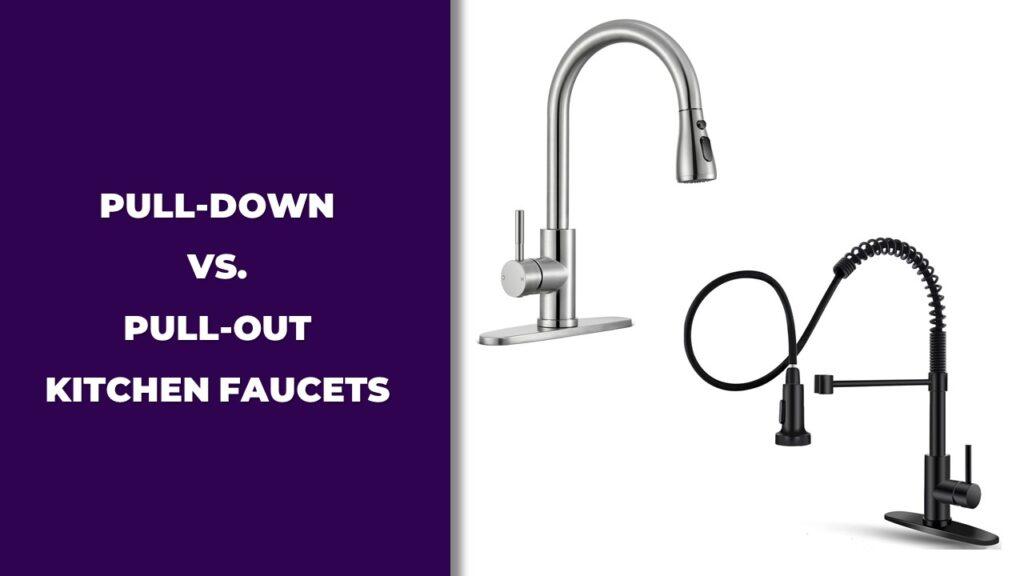
Pull down kitchen faucets have a tall, curved neck with a spray head that pulls straight down into the sink. They’re ideal for deep sinks and filling tall pots. Pull out kitchen faucets have a shorter spout with a spray head that pulls out toward you. This makes them easier to use in small spaces or shallow sinks.
In this article, you’ll learn the key differences between pull down vs pull out kitchen faucets. We’ll explain how each one works, what kind of sink or kitchen layout they suit, and what pros and cons come with each type.
Comparison Between Pull-Down vs. Pull-Out Kitchen Faucets
If you’re stuck choosing between a pull-down or pull-out faucet, you’re not alone. Both are great options, but they work a bit differently and fit different types of kitchens. The main difference lies in how the spray head moves and the kind of space you have around your sink.
Pull-down faucets are known for their tall, curved necks and are often used in larger, deeper sinks. Pull-out faucets, on the other hand, are more compact and pull out toward you, which works better if you’re dealing with limited counter space or shallow sinks. Here’s a quick side-by-side look to help you compare them easily.
| Feature | Pull-Down Faucet | Pull-Out Faucet |
| Spray Head Direction | Pulls straight down into the sink | Pulls out toward you |
| Ideal For | Large or deep sinks | Small sinks or compact spaces |
| Hose Length | Typically shorter than pull-out | Usually longer and more flexible |
| Design Style | High-arc, modern design | Low-profile, minimalist design |
| Spray Modes | More advanced options | Simpler, basic toggle options |
| Ergonomics | More comfortable to hold and use | Less ergonomic but offers flexible reach |
What Is a Pull-Down Kitchen Faucet?
A pull-down kitchen faucet is a type of faucet with a tall, curved spout and a spray head that pulls straight down into the sink. It’s designed for deep sinks and helps with rinsing dishes, filling tall pots, and cleaning hard-to-reach corners.
This style has become popular in modern kitchens because of how smooth and simple it is to use, especially when paired with high-end kitchen faucets that combine performance with polished design. You pull the spray head down, and it snaps right back into place when you’re done. It looks sleek and works well in busy kitchens where you need extra reach and control.
How It Works
Pull-down faucets come with a high-arc neck that gives the spray head enough room to be pulled down directly into the sink. The spray head is connected to a hose tucked inside the faucet. Many models include a magnetic or weighted docking system, so the spray head stays in place when you’re not using it.
Most pull-down faucets also come with buttons or switches on the spray head to change water flow settings. You can easily switch between a steady stream and a more powerful spray.
Ideal Kitchen Setup
Pull-down faucets are best for kitchens with:
- Large or deep sinks
- Plenty of vertical space above the sink
- Tasks like washing big pans, filling pitchers, or rinsing produce
If you have overhead cabinets right above the sink or a shallow sink bowl, this type might not be the best fit since the high neck needs some room to function comfortably.
Pros and Cons
Pros:
- Ideal for filling and cleaning large pots and pans
- Works well with deep kitchen sinks
- Often includes multiple spray modes
- Stylish, modern appearance
- Easier to direct water exactly where you need it
Cons:
- Can splash in shallow sinks
- May not fit under low cabinets
- Usually has a shorter hose than pull-out faucets
What Is a Pull-Out Kitchen Faucet?
A pull-out kitchen faucet features a short, compact spout with a spray head that pulls out toward you. It works well in small kitchens and gives you more control when rinsing or cleaning around the sink.
Pull-out faucets don’t take up much vertical space, making them a good choice if you’ve got low-hanging cabinets or a shallow sink. They’re all about flexibility, especially when space is tight.
How It Works
Pull-out faucets have a shorter spout and a hose that extends out horizontally when you grab the spray head. The hose tends to be longer than in pull-down models, which means you can stretch it farther to rinse vegetables, wash dishes, or even fill a pot on the counter.
The spray head usually has simple buttons to switch between spray and stream, and some models offer pause features as well. Once you’re done, the hose slides right back into the spout smoothly.
Ideal Kitchen Setup
Pull-out faucets are best suited for:
- Compact kitchens with limited counter space
- Shallow or medium-depth sinks
- Sinks installed under low cabinets
- Daily tasks like rinsing, handwashing, and cleaning up
They’re great when you need to reach without taking up extra room, especially in apartments, RVs, or galley-style kitchens.
Pros and Cons
Pros:
- Takes up less space, great for tight areas
- Long hose provides flexible reach
- Easier to use in shallow sinks
- Reduces splash
- Often fits better with low cabinets
Cons:
- Not ideal for filling very tall pots
- It may feel less ergonomic for some users
- Fewer spray settings compared to pull-down models
- Not as stylish or high-profile in design
Key Differences Between Pull-Down and Pull-Out Faucets
The key differences between pull-down and pull-out faucets are in their design, hose movement, spray control, and overall handling. Pull-down faucets have a tall neck and spray head that drops into the sink, making them perfect for deep sinks and big tasks. Pull-out faucets have a shorter spout with a spray head that pulls out toward you, which works better in tight spaces or shallow sinks.
These differences affect how each faucet performs in everyday kitchen use, and understanding them starts with knowing what a kitchen faucet actually does, from water delivery to spray patterns and flow control.
Design and Aesthetics
Pull-down faucets usually feature a high-arc spout. They make a bold statement and often become the centerpiece of a modern kitchen. You’ll find them in stylish finishes, sleek shapes, and touchless models that fit right in with updated kitchen décor.
Pull-out faucets have a lower profile and a more compact look. They blend in better with smaller or traditional kitchen setups. While they may not look as dramatic, their simple, clean design can still look sharp in the right space.
Reach and Hose Flexibility
Pull-down faucets work best in deep sinks, where you can make full use of the vertical space. Their hose is built into the tall spout, giving you plenty of downward reach but less horizontal movement.
Pull-out faucets, on the other hand, offer better side-to-side flexibility. The hose is often longer, and the head pulls out directly toward you. That makes them easier to maneuver, especially if you want to fill a pot on the counter or rinse off veggies at the edge of the sink.
Spray Modes and Control
Pull-down faucets typically give you more spray options. You might see settings like aerated stream, wide spray, or even a pause button. The buttons are usually placed right on the spray head for quick toggling while you’re working.
Pull-out faucets usually stick to simpler controls. Many offer a stream and spray mode, and that’s enough for basic cleaning and rinsing. If you don’t need extra modes, this type keeps things straightforward and easy.
Ergonomics and Ease of Use
Pull-down faucets are often easier to grip and aim because of their natural downward angle. They’re especially handy for tall users or for those who regularly deal with heavy pans or deep sink cleaning.
Pull-out faucets may feel more natural for people who prefer a sideways reach. They’re great for folks who have limited wrist movement or arthritis, as the lower angle requires less effort to control. But for larger tasks, they may feel slightly less comfortable over time.
Which One Should You Pick? (Decision Guide)
To choose between a pull-down and pull-out faucet, think about your sink size, kitchen space, daily habits, and personal taste. Pull-down faucets work well in deep sinks and modern kitchens. Pull-out faucets are great for smaller spaces and flexible tasks.
Use the points below to match your faucet to your kitchen without second-guessing later.
Based on Sink Size
If your sink is deep and wide, a pull-down faucet will give you better control. The height lets you clean big items without splashing everywhere.
If you have a smaller or shallower sink, go with a pull-out faucet. It fits tighter spaces and helps reduce splashes that might spill onto the counter.
Based on Kitchen Space
A pull-down faucet needs enough room above the sink. If your cabinets hang low or your window sill gets in the way, this style might feel cramped.
A pull-out faucet has a shorter body, which makes it a better choice for galley kitchens, RVs, or apartments with tight clearances.
Based on Daily Tasks
Are you always washing large pots, pans, or produce? A pull-down faucet gives you more clearance and better angles for those big jobs.
If you mostly rinse small dishes or fill things on the counter, a pull-out faucet’s longer hose and easier control will save time and effort.
Based on Style Preferences
Pull-down faucets have a modern, showpiece look. They fit well in updated kitchens and pair nicely with stainless steel appliances or minimalist finishes.
Pull-out faucets lean more toward function than flash. If your style is simple, practical, and low-profile, this might be a better visual match.
Additional Features to Consider in Both Types
Whether you choose a pull-down or pull-out faucet, there are a few extra features worth paying attention to. Things like docking systems, spray button design, touchless activation, and hose retraction all play a big role in how the faucet performs day to day.
First, look at how the spray head docks. Some brands use magnets (like Delta’s MagnaTite), while others rely on weights or snap-in clips. A magnetic dock helps keep the spray head secure and prevents it from hanging loose or flopping over time.
Next, test the spray button or toggle. Is it easy to press with wet hands? Can you switch between spray modes quickly without fumbling? Some spray heads have a pause button too, which is handy when you’re moving from one pot to another without turning off the water.
Finally, think about extras like touch or motion-activated controls. These features allow you to turn the faucet on and off without touching the handle, which is especially helpful when your hands are messy or full. While these upgrades add cost, they can make your kitchen workflow smoother and more hygienic.
Final Verdict: Pull-Down vs. Pull-Out Faucet
Both pull-down and pull-out kitchen faucets serve a purpose, and the right choice depends on your setup. If you have a large or deep sink and prefer modern designs, a pull-down faucet gives you better reach and more control. It’s ideal for filling tall pitchers, rinsing big pans, and handling larger tasks with ease.
On the other hand, if your kitchen is compact or your sink is shallow, a pull-out faucet offers better flexibility in a smaller footprint. It lets you stretch the hose farther, reduce splash, and work comfortably without needing much vertical space.
At the end of the day, the choice between pull-down vs. pull-out faucets comes down to your kitchen size, habits, and personal style. If you’re still weighing options, explore the types of faucets available to see how each one might fit into your layout.
Related FAQs
Which Is Better for Small Kitchens: Pull-Down or Pull-Out Faucet?
Pull-out faucets are usually better for small kitchens. They take up less space, fit under low cabinets, and offer more flexible hose reach for shallow sinks or compact layouts.
Can I Install a Pull-Down Faucet in a Shallow Sink?
You can, but it may not be ideal. Pull-down faucets tend to splash more in shallow sinks due to their height and water pressure. A pull-out faucet might be a better fit in this case.
Do Pull-Down Faucets Offer More Spray Options Than Pull-Out?
Yes, most pull-down faucets come with more spray modes, such as stream, spray, and pause. Pull-out models usually have simpler controls with one or two settings.
Which Faucet Type Is Easier to Use for People With Limited Hand Strength?
Pull-out faucets are often easier to use for people with arthritis or limited grip strength. They require less reach and the spray head is closer and easier to maneuver.
Are Pull-Out Faucets Less Durable Than Pull-Down Models?
Not necessarily. Both types can be durable if made by a quality brand. Durability depends more on build materials, hose design, and the type of docking system used.

Dylan Foster is a family man with years of hands-on experience in plumbing, household maintenance, and fixing everyday issues around the home. A former plumber, Dylan knows what it’s like to deal with tricky leaks, worn-out parts, and all the little problems that pop up in a house. From plumbing repairs to kitchen fixes and garden hose setups, he’s done it all. Dylan shares real-world solutions to help others keep their homes running smoothly and avoid costly mistakes.




